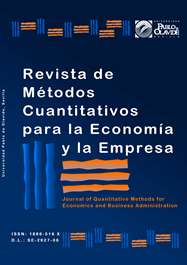Net flow rates frente a roll rates como metodologías de predicción en préstamos al consumo morosos
DOI:
https://doi.org/10.46661/revmetodoscuanteconempresa.5489Palabras clave:
roll rates, net flow rates, riesgo de crédito al consumo, morosidad, impagos, pérdida esperadaResumen
Las roll rates y las net flow rates pueden verse como la evolución de las ageing of accounts receivable y las cadenas de Markov. Son metodologías aceptadas para modelizar el comportamiento de los préstamos al consumo morosos por buckets y para predecir pérdidas, pero nos encontramos que con bastante frecuencia se usan incorrectamente como conceptos intercambiables, aunque las roll rates siguen cuentas individuales a través de los buckets en meses consecutivos y las net flow rates solo comparan buckets consecutivos en meses consecutivos. Determinamos sus matrices de probabilidades de transición y las analizamos en condiciones estacionarias y de estado estable. Las net flow rates tienen muchas ventajas sobre las roll rates, pero un hallazgo bastante importante para las instituciones financieras y los supervisores es que las net flow rates históricas no son conservadoras para hacer predicciones: cuando el nivel de nuevos impagos se dispara, las net flow rates contemporáneas tenderán a ser más bajas de lo que serían en condiciones de estado estable, creando un sentimiento de falsa confianza y llevando a la subestimación de las pérdidas futuras.
Descargas
Citas
Acenden (2012). Overview of arrears roll rate. UK and Ireland mortgage and property monthly, 6, 1-3. https://www.acenden.com/docs/default-source/newsletter-uk-ireland-mortgage-property-monthly/uk-and-ireland-mortgage-and-property-monthly-issue-6-nov-2012.pdf.
Anderson, R. (2007). The credit scoring toolkit: theory and practice for retail credit risk management and decision automation. Oxford University Press.
Clemons, E., & Thatcher, M. (1998). Capital One: Exploiting an information-based strategy. In System Sciences (Ed.), Thirty-First Hawaii International Conference, 6, 311-320. https://doi.org/10.1109/HICSS.1998.654788
Coffman, J.Y., & Chandler, G.G. (1983). Applications of performance scoring to accounts receivable management in consumer credit. Krannert Graduate School of Management, Purdue University. http://citeseerx.ist.psu.edu/viewdoc/download?doi=10.1.1.197.9454&rep=rep1&type=pdf
Cyert, R.M., & Thompson, G.L. (1968). Selecting a portfolio of credit risks by Markov chains. The Journal of Business, 41(1), 39-46.
Cyert, R.M., & Trueblood, R.M. (1957). Statistical sampling techniques in the aging of accounts receivable in a department store. Management Science, 3(2), 185-195.
Cyert, R.M., Davidson, H.J., & Thompson, G.L. (1962). Estimation of the allowance for doubtful accounts by Markov chains. Management Science, 8(3), 287-303.
FDIC (2007). Risk Management Examination Manual for Credit Card Activities. Division of Supervision and Consumer Protection. https://www.fdic.gov/regulations/examinations/credit_card/pdf_version/
Hong Kong Monetary Authority (2006). Supervisory Policy Manual: Credit Card Business. Hong Kong Monetary Authority.
Kellett, D. (2011). UK Credit Card Loss Forecasting Using Markov Chain Models. In Capital One (Ed.), Credit Scoring and Credit Control XII conference. Edinburgh.
Office of the Comptroller of the Currency (2004). Retail Lending Examination Procedures. Comptroller's Handbook. U.S. Department of the Treasury. http://www.occ.gov/publications/publications-by-type/comptrollers-handbook/_pdf/retaillendingexaminationprocedures.pdf
Office of the Comptroller of the Currency (2015). Credit Card Lending. Comptroller’s Handbook. U.S. Department of the Treasury. https://www.occ.treas.gov/publications/publications-by-type/comptrollers-handbook/credit-card-lending/pub-ch-credit-card.pdf
Office of the Comptroller of the Currency (2016). Installment Lending. Comptroller’s Handbook. U.S. Department of the Treasury. https://www.occ.treas.gov/publications/publications-by-type/comptrollers-handbook/installment-lending/pub-ch-installment-lending.pdf
PwC (2015). IFRS 9: Credit Modelling and Implementation. http://www.pwc.com/ca
Rosenberg, E., & Gleit, A. (1994). Quantitative methods in credit management: a survey. Operations Research, 42(4), 589-613.
Santander Consumer Finance E.F.C. (2016). Securitization Fund Santander Consumer Spain Auto 2016-1. [Issue Prospectus]. https://www.cnmv.es/Portal/Consultas/Folletos/FolletosEmisionOPV.aspx?isin=ES0305124002
SAS (2014). CCAR: An Appraisal of Current Practices. https://www.sas.com/content/dam/SAS/en_us/doc/whitepaper1/ccar-appraisal-of-current-practices-107211.pdf
So, M.M., & Thomas, L.C. (2010). Modeling and model validation of the impact of the economy on the credit risk of credit card portfolios. Journal of Risk Model Validation, 4, 93-126.
Stretton, C., & Burra, P. (2011). Financial instruments impairment: Adapting to change. Johannesburg: Deloitte. https://www.iasplus.com/de/binary/safrica/1107impairmentaccounting.pdf
Publicado
Cómo citar
Número
Sección
Licencia

Esta obra está bajo una licencia internacional Creative Commons Atribución-CompartirIgual 4.0.
El envío de un manuscrito a la Revista supone que el trabajo no ha sido publicado anteriormente (excepto en la forma de un abstract o como parte de una tesis), que no está bajo consideración para su publicación en ninguna otra revista o editorial y que, en caso de aceptación, los autores están conforme con la transferencia automática del copyright a la Revista para su publicación y difusión. Los autores retendrán los derechos de autor para usar y compartir su artículo con un uso personal, institucional o con fines docentes; igualmente retiene los derechos de patente, de marca registrada (en caso de que sean aplicables) o derechos morales de autor (incluyendo los datos de investigación).
Los artículos publicados en la Revista están sujetos a la licencia Creative Commons CC-BY-SA de tipo Reconocimiento-CompartirIgual. Se permite el uso comercial de la obra, reconociendo su autoría, y de las posibles obras derivadas, la distribución de las cuales se debe hacer con una licencia igual a la que regula la obra original.
Hasta el volumen 21 se ha estado empleando la versión de licencia CC-BY-SA 3.0 ES y se ha comenzado a usar la versión CC-BY-SA 4.0 desde el volumen 22.










